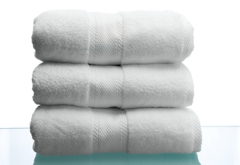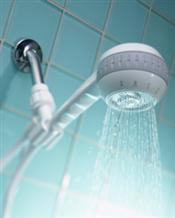Washington Post Eco-Chic Your Shower
By now you probably know that a shower uses half the amount of water of a bath, but how can you take that one step further without rushing through your precious morning me-time in the shower? Luckily there are plenty of high quality eco-friendly towels, showerheads and beauty products that'll maintain your luxurious experience while giving the environment a break.
Water Conservation
Start saving even more water by installing a low-flow showerhead, which can cut water usage in half by allowing only 2.5 gallons of water per minute (gpm) or less to stream out. Since 1992 all showerheads manufactured in the US must be low-flow. The previous standard was 4.5 gpm. So according to Alexandra Kennaugh, Director of the Natural Resources Defense Council's Green Living Initiatives, if a family of four trades in for a 2.5 gpm model, they can save about 2,000 gallons of water a year which is roughly the contents of a swimming pool and enough water to sustain themselves for 26 years.
If your home was constructed after '92 you probably have one already, but if you don't have one, get one. And even if you have a 2.5 gpm model, you can go lower and save even more water. They're easy to install yourself-usually you can just unscrew the old one and attach the new one-and with the latest models you probably won't notice a difference until you pay your water bill. If you're worried about strong water pressure, try one with multiple spray settings like Oxygenics TriSpa Series. It has three ranging from massage to soothing and only uses a maximum of 1.9 gpm. Or the Bricor Elite Showerhead uses vacuum technology to increase water pressure-you'd never guess only 1.5 gpm are entering your shower. If it's design you're after, consider Delta's Michael Graves Touch-Clean Showerhead with three spray modes and a 2.5 gpm rating.
So how else can you reduce water usage? Renée Loux, author of Easy Green Living, suggests cutting your shower time by a minute or even 30 seconds. A little really goes a long way because even though it won't feel like much of a sacrifice, you can save a few gallons of water every day. Or cut your household shower time by sharing one with your sweetie. You might also want to try turning off the faucet while you shave-a favorite eco practice of Cameron Diaz. And when you apply a ten-minute hair mask, no one says you have to stay in the shower watching the water run down the drain.
Don't forget that it takes energy to heat your shower's water too. Again, you can look to a showerhead to help. The Roadrunner Eco-Friendly Showerhead has a temperature gage built in so you can walk away while the shower warms up. Once it reaches 95 degrees it'll slow the water flow to a trickle until you're ready to hop in. It also has an impressive 1.59 gpm rating and is a favorite of Amy Brenneman and Kelly Rutherford. Hot water is actually bad for your skin anyway. It removes natural oils so take a warm, not hot shower. Loux suggests turning the water cold for the last 30 seconds of your shower. "It's good for your skin, closes pores, invigorates your body and revs up your metabolism while you save a little energy," she says.
Clear the Air
While you're in DIY mode install a water filter too-it's an inexpensive investment and taking chlorine out of the equation will not only improve your hair and skin, but it'll improve air quality too. Usually water is chlorinated to keep it safe, but that doesn't mean it's healthy. Chlorine is a gas by nature, but is forced into liquid form for water purification. When water is sprayed into a shower, the chemical returns to its gaseous form so you end up breathing it in, says Loux. While it's not a huge amount, studies have found we absorb more chlorine in a shower than by drinking it. Other studies have found that showering in water can increase the risk of bladder cancer.
Beyond the scary facts, chlorine is drying. Once you install a filter, you'll experience more supple skin and softer hair, Loux raves. Most are easy to add to any existing showerhead including low-flow varieties-you simply screw the filter onto your existing shower arm. Usually you only need to replace the filter every 6 months and that's just as simple. A basic model like the Rainshow'r Dechlorinating Shower Filter will do the trick. But for added beauty benefits, the Wellness Shower Filter replaces chlorine with good-for-you silican, potassium and magnesium. Or get your low-flow showerhead and water filter all in a one-two punch. The Oxygenics Body Spa Handheld Showerhead with April Shower Filtration does it all and feels luxe. You can even find spa-like rainfall-style filtrating models such as the Sunflower Showerhead.
The EPA estimates that indoor air quality is 2 to 10 times more polluted than outdoor air quality. The biggest culprit contributing to that level in your bathroom is a PVC shower curtain. The strong odor you smell when you open a new PVC shower curtain can instantly make you nauseous or give you a headache and it often sticks around for days, weeks or even months. The stench comes from volatile organic compounds (VOCs) being released into the air. According to Mike Schade, PVC Campaign Coordinator for The Center for Health, Environment & Justice, their study shows PVC plastics can cause developmental damage and damage the central nervous, respiratory and reproductive systems as well as the liver. The same study found some chemicals stuck around for 28 days after a new curtain was hung. You're not just doing damage to the air in your bathroom either; it circulates throughout your entire home. So avoid plastic shower curtains labeled as "vinyl" or "PVC" and ones with the number "3" recycling symbol.
The greenest solution is to skip the curtain altogether and install a glass door. Sure it's an investment, but it'll improve the look and feel of your bathroom and stop you from constantly having to replace your liner. If you want a less labor-intensive solution, look for natural fabrics. Some work well without a liner, especially if you have a well-ventilated bathroom to help them dry. Canvas naturally wicks away moisture while hemp curtains are naturally mildew resistant. Or if you can't give up your liner, Loux suggests using an organic cotton curtain lined with a nylon one. While nylon is synthetic, it doesn't pollute your air like PVC. But if you think you've found a goldmine with a water-resistant fabric liner, it's probably too good to be true according to Loux. Most use the same type of chemicals found on non-stick pans-they're not healthy for you or the environment. Check out our favorite green options in Sprig's Top 10 Most Stylish Shower Curtains.
Of course, with fabric curtains mildew is more likely to grow. Avoid bright white styles because mildew will be more visible and can stain. Also, make a habit of throwing your curtain in the washing machine once a month. Even better, hang it in the sun to dry periodically-sunlight is one of the best ways to kill mildew according to Loux. She also suggests filling a spray bottle with water and a few drops of lavender, rosemary or tea tree oil. Spray it on your curtain post shower. It'll smell wonderful and help kill mildew all at the same time.
Another great bathroom addition is a plant that tolerates low light and thrives in humidty. "They're a brilliant way to filter your air," says Loux. They produce fresh oxygen, pull chemicals from the air and help regulate humidity to reduce mold and microbes.





